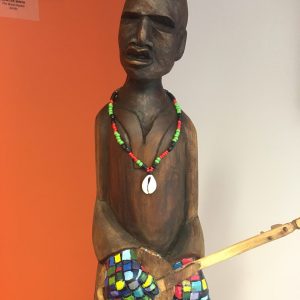Exhibiting artist:
Selden Gallery 2007 “Art of African American Artists” curated by Maizelle
Offsite Gallery “Art of Prominent African American Artists” curated by Maizelle
Offsite Gallery “2017 Renaissance” curated by Maizelle
Offsite Gallery 2019, June 28 – August 9 “Make Me Wanna Holler” curated by Maizelle
“When you look at Alexis Joyner’s sculptures, it becomes obvious that familial relationships are at the core of his work. “I find myself drawn to the special bond between mother and child,” Joyner notes. “I often address social issues and concerns and I like to gently remind young folk that they don’t need to reinvent the wheel.” A native of Southampton County, Virginia, Joyner created his first three-dimensional pieces at age 12 by carving faces on walking sticks and canes. More serious explorations began at Virginia State College where he received his BS Degree in Fine Arts. There, Joyner produced Mama, a soft-shaped canvas painting in the fall of 1974 and in 1975. His first large wood piece, entitled Cherry, was a depiction of Nat Turner’s wife rendered in black walnut, it is an homage to the legendary slave revolt of 1831 that occurred in the county where Joyner was born. Joyner later earned an MFA from Norfolk State and Old Dominion Universities where he cites Dr. Rod Taylor (NSU) and Mr. Victor Pickett (ODU) as significant influences as well as the work of sculptor Elizabeth Catlett. “She was fearless in making statements and social commentary and her works were finished to a point of near perfection,” he says. Joyner’s work, which he describes as “visual sermonettes,” has been exhibited in a variety of venues, including NSU’s James Wise Gallery, and select pieces can be seen at Arts of the Albemarle (516 E. Main St.). His works are among the collections of Chatanooga State College, the Daura Gallery at Lynchburg College, and the Schomburg Center for Research in Black Culture, New York Public Library. Joyner’s work is meant to be transmitters of morals and old fashioned values. Many of his works have religious themes. He considers them to be visual sermonettes.
Watch a video of the exhibition in 2017.



